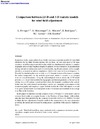Please use this identifier to cite or link to this item:
https://accedacris.ulpgc.es/handle/10553/16336
| Title: | Comparison between 2.5-D and 3-D realistic models for wind field adjustment | Authors: | Ferragut Canals, Luis Montenegro, R. Montero, G. Rodríguez, E. Asensio Sevilla, María Isabel Escobar, J. M. |
UNESCO Clasification: | 120613 Ecuaciones diferenciales en derivadas parciales 2509 Metereología 1206 Análisis numérico 250121 Simulación numérica 250902 Contaminación atmosférica, et al |
Keywords: | Wind field modelling Mass consistent models Parameter estimation Genetic algorithms Adaptive mesh refinement, et al |
Issue Date: | 2010 | Journal: | Journal of Wind Engineering and Industrial Aerodynamics | Abstract: | In previous works, many authors have widely used mass consistent models for wind field simulation by the finite element method. On one hand, we have developed a 3-D mass consistent model by using tetrahedral meshes which are simultaneously adapted to complex orography and to terrain roughness length. In addition, we have included a local refinement strategy around several measurement or control points, significant contours, as for example shorelines, or numerical solution singularities. On the other hand, we have developed a 2.5-D model for simulating the wind velocity in a 3-D domain in terms of the terrain elevation, the surface temperature and the meteorological wind, which is consider as an averaged wind on vertical boundaries... | URI: | https://accedacris.ulpgc.es/handle/10553/16336 | ISSN: | 0167-6105 | DOI: | 10.1016/j.jweia.2010.04.004 | Source: | Journal of Wind Engineering and Industrial Aerodynamics [ISSN 0167-6105], v. 98 (10-11), p. 548-558 | Rights: | by-nc-nd |
| Appears in Collections: | Artículos |
SCOPUSTM
Citations
14
checked on Jun 8, 2025
WEB OF SCIENCETM
Citations
13
checked on Jun 8, 2025
Page view(s)
115
checked on Jul 20, 2024
Download(s)
229
checked on Jul 20, 2024
Google ScholarTM
Check
Altmetric
Share
Export metadata
Items in accedaCRIS are protected by copyright, with all rights reserved, unless otherwise indicated.
